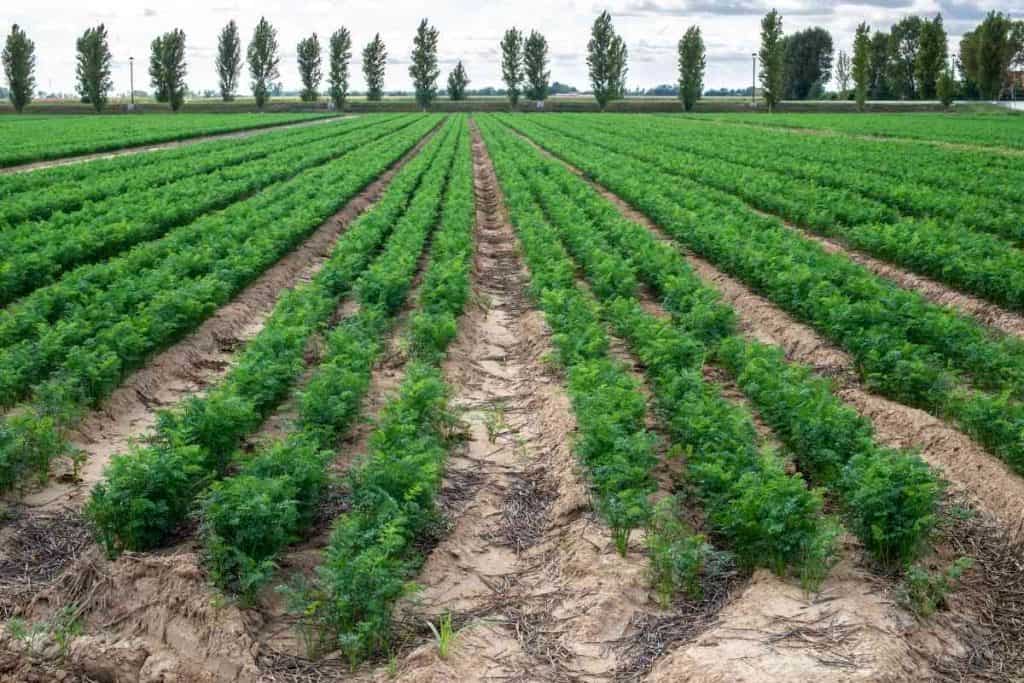Even though they are biennials, carrots are wildly grown and harvested as annual plants. Biennial growth is simply a tactic carrots have adopted to ensure they grow in an area that has shorter growing seasons.
Meanwhile, the best soil for growing healthy carrots is loose sandy loamy with good drainage.
The duration of time it will take from when you plant a Carrot to when it's ready for harvest depends on the species you grow and your local climate. Generally, between 75 to 80 days, they should be ready for harvest.
There are four key carrots growing stages: Germination, vegetative, dormant, and seedling stages.
See more details below.
Table of Contents
Carrots Growing Stages

Below are the important carrots growing stages you should know about when planning to grow carrots in your garden:
Read Also: Is Carrot a Fruit?
Stage 1: Germination
The Germination of a Carrot seed often takes 1 to 3 weeks based on the weather condition at any point in time. Its Germination is often faster in warmer weather conditions and slower in cold-weather conditions.
Since it is a cold-weather plant, its seeds can be grown when soil temperatures are up to 50 degrees or above, yet, will thrive better with 60 degrees or above. The optimum soil temperature germination of carrot seed is at 80 degrees.
This optimum temperature becomes the point of heating mats on seeds that germinated indoors. Several garden plants possess seeds, which germinate faster under warmer soil temperatures.
When using a heating mat, endeavor to get rid of the seedlings after 50% of them have sprouted.
Note that seedlings' best-growing condition is under cooler temperature ranges of 55 to 75 degrees.
And, the longer the carrot seeds remain rooted in the ground without sprouting, the greater chance it has of producing bad germination rates and, at this point, certainly needs to be replanted.
Again, Carrot seeds are small and light and only planted ¼″ under the ground; therefore, heavy rains can rearrange them.
The use of row covers in the early growing season helps to warm up soil temperatures to about 5 degrees or more and helps to reduce the worries you might have about the potential effects of the early spring weather.
It also helps to scare away pests from the seedlings after they sprout. Mulch is also an important factor that helps warm soil temperatures and prevent weeds but will fail to make available the physical barrier amongst the plants, pests, and rain/frost.
Carrot seeds require adequate watering after planting. It helps to set up the right platform and, at the same time, provide the seeds with the moisture they require to germinate.
Check on the seeds and once you find out that the seeds are drying, endeavor to re-water the soil to keep the seeds moistened.
Stage 2: Vegetative
The Carrot is a slow-growing plant. During this stage, the seedlings depend on their basic food stores to strengthen the essential processes, yet the stores decrease with every passing day.
A huge, primary root form, otherwise called the taproot, and little secondary roots develop.
The taproot is a store for food that is crucial for Carrot growth. Also, during this stage, the first true leaf of the Carrot starts appearing, which is a smaller version of the mature leaves, and photosynthesis begins.
The plant at this stage no longer depends on the gardener's input to feed. It can now produce its food.
Read Also: Is Carrot Man Made?
Stage 3: The Dormant Period
The Carrot seeds will continue to grow above and beneath the ground until the temperature begins to be constantly less than 50 degrees.
At that point, the plant will start entering its dormant period. At its dormant stage, the foliage on the earth's surface will die again, and growth beneath the earth's surface will cease.
The dormancy period is seen as a survival strategy utilized by several plants that allow a long growing season to live and reproduce in an environment with shorter growing seasons.
For instance, if you live in an area where winter temperatures will nearly often reach the single digits and sometimes colder, and you mistakenly or forgetfully missed carrots at harvest or left them in the ground, they could make it back up the next year.
Meanwhile, the snow on the surface serves as insulation, which can help keep soil temperatures warmer.
Stage 4: Flowering & Seedling Stage
The flowering stage is the stage at which the Carrot plant starts to produce flowers. It is also called the seedling stage. The seedling stage can only occur or come to be if you're patient enough not to harvest your carrots in the first planting season.
Failure to harvest during the first life cycle leads to the Carrots' second life cycle, which usually occurs after the dormant period, and here, it begins to produce seeds.
Carrot seeds are very small and could take between 10 to 15 days of planting to germinate. Then, once it is about 3 to 4 months after Germination, you can start harvesting your Carrots and keep up with the harvest routine every year.
Do Carrots Come Back Every Year?
Remember, Carrots are biennial plants, which have two years life cycle before, and after that, they die. Therefore, they can be grown and harvested as annuals. To answer the question; YES, Carrots come back every year, but only within their natural life cycle period (two years).
When you abandon your Carrots to overwinter under the ground, they will grow flowers and seeds in the upcoming year, but the Carrot itself cannot grow much; therefore, it can start having a springy and woody texture.




